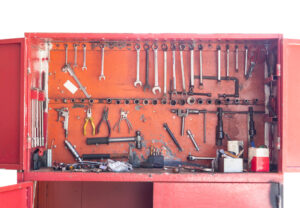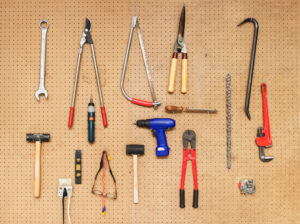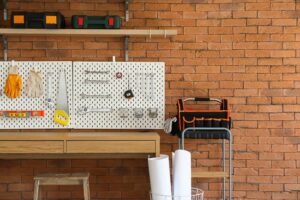Greetings, fellow workshop enthusiasts! If you’re like me, you understand the importance of having a well-organised small workshop. No matter if you’re a woodworker, home renovator, or hobbyist, having a tidy and functional workspace can make all the difference.
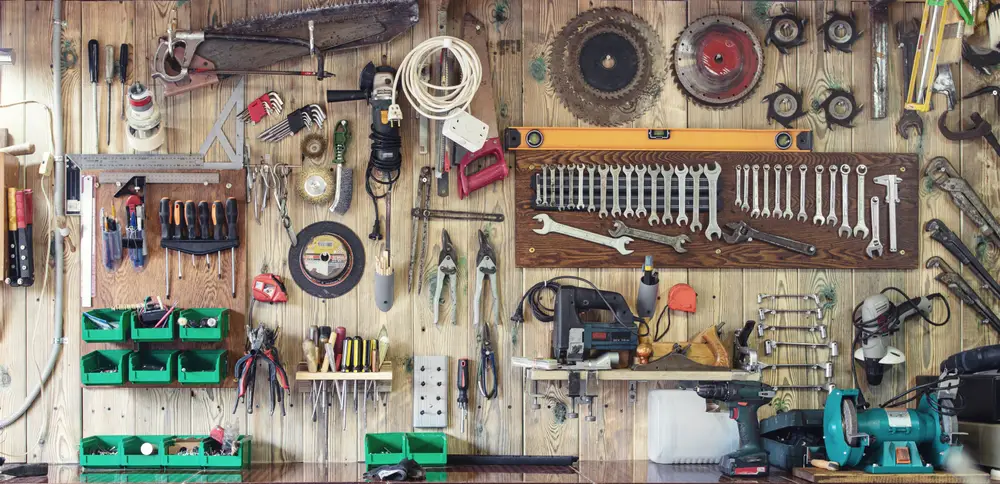
That’s why I’m here to share with you some valuable tips and tricks to help you organise your tools and transform your small workshop into an organised haven. From clever storage solutions to customised workbenches, get ready to create a space that inspires creativity and efficiency.
Key Takeaways:
- Organising a small workshop requires a personalised approach.
- Create zones and use cabinetry to keep like items together.
- Maximise vertical space with customised storage solutions.
- Give everything a designated home and utilise open storage.
- Enjoy a clutter-free and efficient workshop experience.
Create Zones and Use Cabinetry for Like Items
When it comes to organising your tools in a small workshop, creating zones and utilising cabinetry for like items is essential. By doing a thorough inventory and sorting your tools into categories, such as power tools, small hand tools, and other items, you can create efficient workspaces within your workshop.
Once you have sorted your tools, it’s time to designate specific zones for each category. This allows you to easily locate and access the tools you need for a particular task. Additionally, using cabinetry to store like items together helps to keep your workshop tidy and organised. For example, you can dedicate a DIY storage cabinet for table saw equipment and place it near the table saw for easy access.
Incorporating cabinetry into your workshop not only enhances the organisation of your tools but also improves the overall functionality of the space. You can choose from a variety of cabinetry options, such as wall-mounted cabinets, tool chests, or even custom-built workbenches with built-in storage compartments. By keeping like items together and creating designated zones, you can streamline your workflow and ensure that everything is within reach when you need it.
Table: Example Zones and Cabinetry for Tool Organisation
| Zone | Cabinetry |
|---|---|
| Power Tools | Wall-mounted cabinet with labeled compartments |
| Hand Tools | Tool chest with multiple drawers |
| Hardware and Fasteners | Stackable storage bins |
| Cutting and Measuring Tools | Pegboard with hanging hooks |
By following these tool organisation tips and creating zones with the help of cabinetry, you can transform your small workshop into a well-organised and efficient space. With everything in its designated place, you’ll save time searching for tools and enjoy a more productive workflow. So, get started on organising your workshop today and experience the benefits of a clutter-free and functional workspace.
Maximise Vertical Space with Customised Storage Solutions
When it comes to organising your workshop, maximising vertical space is key. Customised storage solutions allow you to make the most of your available space while keeping your tools easily accessible. One effective way to achieve this is by incorporating pegboard into your storage system. By installing a pegboard backing on your tool cabinet or workbench, you create a versatile surface for hanging tools of various sizes. This not only keeps your tools visible and within reach, but it also helps to free up valuable workspace on your bench or countertop.
In addition to pegboard, consider utilising overhead storage options. Wall-mounted shelves or ceiling racks provide ample storage space for larger, less frequently used tools. This way, you can keep your workspace clutter-free while still having easy access to all your tools when needed. Customising storage pieces to fit your specific needs and space ensures that every inch of vertical space is put to good use.
Another customised storage solution to maximise vertical space is to build storage cabinets with specific compartments for your tools. Incorporate pull-out drawers, shelves, and dividers to create designated spaces for each type of tool. This not only keeps your tools organised but also helps to prevent damage and prolong their lifespan. By customising your storage to fit your tools, you can create a visually appealing and functional workshop that enhances your productivity.
Table: Comparison of Storage Solutions
| Storage Solution | Advantages | Disadvantages |
|---|---|---|
| Pegboard | – Keeps tools visible and easily accessible – Saves workspace – Versatile hanging options | – Limited weight capacity – Requires proper installation |
| Overhead Storage | – Maximises vertical space – Keeps less frequently used tools out of the way – Provides easy access | – May require a ladder or step stool to reach – Limited weight capacity |
| Customised Cabinets | – Designated spaces for tools – Prevents damage and prolongs tool lifespan – Organised and visually appealing | – Requires building skills or professional assistance – Cost of materials and customization |
With these customised storage solutions, you can make the most of your workshop space and keep your tools organised and easily accessible. By maximising vertical space and creating designated storage spots for each tool, you’ll be able to work efficiently and enjoy a clutter-free workshop environment. Choose the storage solutions that best fit your needs and preferences, and enjoy the benefits of a well-organised workshop.
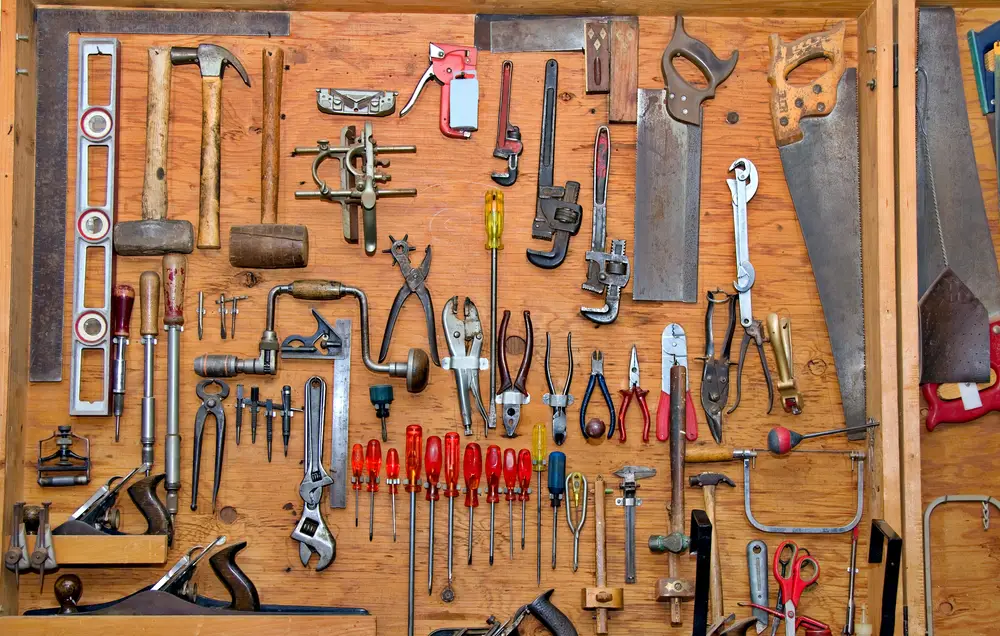
Give Everything a Designated Home and Utilise Open Storage
When it comes to organising my workshop, one of the most important things I’ve learned is to give everything a designated home. Similar to how you organise items in your kitchen, having dedicated storage for tools and materials allows you to easily find and put things away. This not only saves time but also creates a clutter-free environment.
To achieve this, I make use of open storage systems such as shelves, hooks, and magnetic strips on the walls. By keeping frequently used tools visible and easily reachable, I never have to waste time searching for what I need. Plus, it adds a touch of visual interest to the workshop.
Another tip is to avoid storing tools in drawers. Trust me, I’ve made this mistake before, and it only leads to misplacement and a cluttered workspace. Instead, opt for open storage solutions that allow you to see everything at a glance. This way, you can quickly grab the tool you need and get back to work.
By implementing these simple organisational strategies, you can create a workshop that is not only efficient but also a pleasure to work in. So, give your tools and materials a designated home, utilise open storage, and experience the joy of a well-organised workshop!
FAQ
How do I start organising my tools in a small workshop?
Start by doing a thorough inventory and sorting your tools into like categories. Then, create zones in your workshop and use cabinetry to keep like items together.
How can I customise storage pieces in my workshop?
Instead of purchasing generic workbenches or storage cabinets, consider building your own with specific storage spots for your tools. For example, you can build a tool cabinet with a pegboard backing and on the cabinet doors to provide plenty of surface area for hanging tools.
Why is it important to give every tool and material a designated home?
Having dedicated storage for tools and materials allows you to easily find and put things away. Consider using open storage systems, such as shelves, hooks, and magnetic strips on the walls, to keep frequently used tools visible and easily reachable.
Should I store tools in drawers?
It’s best to avoid storing tools in drawers as it can lead to misplacement and a cluttered workspace. Instead, utilise open storage options to keep your tools organised and easily accessible.
How can I maintain an organised workshop?
By implementing these organisational strategies, such as creating zones, customising storage solutions, and utilising open storage, you’ll enjoy a clutter-free and efficient workshop experience.
- Drill Battery Maintenance: Essential Tips for Cordless Drill Battery Care - February 5, 2024
- Troubleshooting Drill Issues - February 5, 2024
- Quick Drilling Techniques - February 2, 2024


